13 July 2017
The Many Lives of Erik Kessels is the first retrospective devoted to the photographic work of the artist, publisher and creative director Erik Kessels (Roermond, Netherlands, 1966). Curated by Francesco Zanot for Camera— Centro Italiano per la Fotografia in Turin, the exhibition presents twenty-seven series of photographs, videos and publications—many of them brought out by KesselsKramer, the publishing house of the advertising agency of the same name that he founded in 1998. The process of accumulation on which Kessels’s entire body of work is founded forms the basis of the layout of the exhibition: devoid of any chronological or narrative structure, it proposes a visual and spatial experience in which the image is continually transformed: laid on the floor, blown up and stuck on the walls, projected or backlit, turned into an architectural object. No genre, subject or theme is excluded from the omnivorous research conducted by the artist, who over the years has focused, on the one hand, on the recovery of lost family albums—starting with the ones that preserve memories of his own life—and, on the other, on the attempt to explore the motivations and consequences of a photography made up of everything, practiced by everyone and shared. The exhibition, open until July 30, is accompanied by a monographic volume of over six hundred pages published by Aperture, with essays by Hans Aarsman, Simon Baker, Erik Kessels, Sandra S. Phillips and Francesco Zanot. After Turin, an expanded version of the exhibition will reopen on August 12 at the NRW-Forum in Düsseldorf, coproducer of the project. We walked through the rooms of Camera with the artist, in order to gain a better understanding of one of the richest and most significant contributions to research into the phenomena of appropriation of vernacular photographic archives and the overproduction of digital images since the year 2000.
How did you get started on your now twenty-year-long research into photography and how has it developed?
First of all, I think it is important to make clear that all the works in the exhibition were produced over a period in which photography was undergoing rapid change. The beginning of my research is connected primarily with my experience as a graphic designer and artistic director. I worked a lot with images in my day job. In advertising and design, the photographs that surrounded me were almost perfect. I felt the need to look at other types of photograph, and my interest was immediately caught by some forms of imperfection. That was how I started, at the end of the nineties, between 1997 and 1998. Then, over the years, encouraged by the first edition of In Almost Every Picture (2002), I realized that I could also uncover real stories behind the series I was collecting. In this exhibition, you can see the whole of my history. Works like 24hrs (2011) and My Feet (2014) represent the age of the internet, when people are copying each other constantly and sharing the same modes of behavior. There has been a true Renaissance in photography, and it is now at its peak. Who knows, perhaps people will soon start taking less pictures, instead of adding to them? In my view, we have all turned into something of an editor: we are accustomed to seeing and working with so many images that we are obliged to make choices. Not just with regard to photography, in reality: we have to choose what to watch, what to listen to, what to read. In the case of the exhibition, what interests me is that people should stop to look for the meaning of the stories that each series brings with it, and start to observe things in a different way. Over the last twenty years, we have all been taught to consume photographs in the same way as we eat fast food.
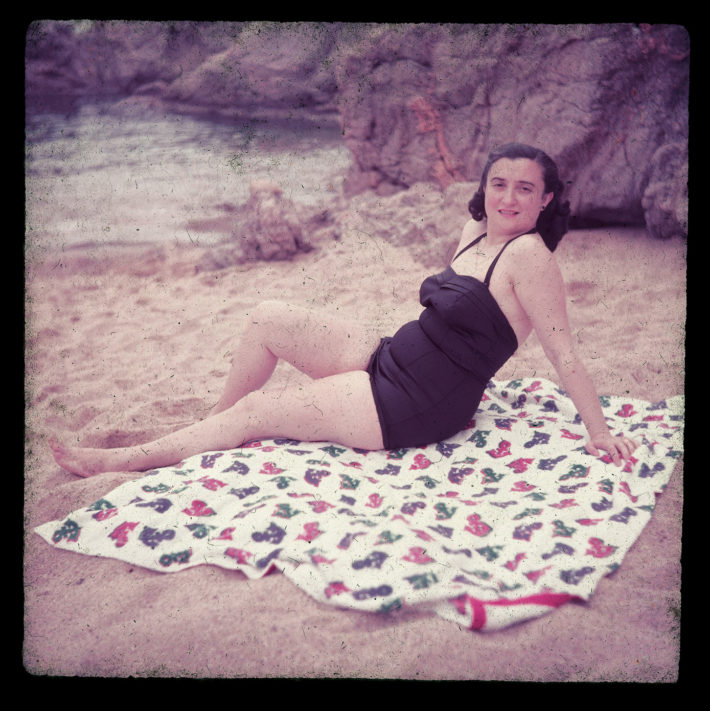
From In Almost Every Picture #1. Published by KesselsKramer and Artimo, Amsterdam, 2002.
Your work has exposed you to a great variety of human behavior. Have you formed an opinion about why people feel the need to go on taking pictures?
I certainly find it fascinating to try to understand this behavior. To give you some examples: in the case of the Spanish woman (In Almost Every Picture #01), we see photographs taken of her over twenty years and in the course of time, as she gets older, she gets smaller and smaller in the shots; people photograph their first child more than any other; they take pictures of their penises with objects alongside (Useful Photography #13), or of their feet (My Feet). In the age of analog photography the average number of photograph albums that people used to produce over the course of a lifetime was six or seven. That’s not many, but it could also be objected: now that people take more pictures, doesn’t that mean that they are more thorough in the way they document their lives? No, I don’t think so. The role of photography has changed: pictures are not taken to preserve memories, but to share them. Today, the life cycle of a photograph is a few minutes, a week at the most. In contrast, albums were once made to last—those images still survive. We cannot exclude the possibility that digital images will disappear in the future. But I must make it clear that I’m not making judgments about one or the other. In the age in which we live there is far more freedom and democracy, everyone is a photographer and it’s been like that for many years now. This is a very positive thing, because in the past photojournalists and artists had a monopoly. They were the ones with the money and the cameras, the ones who could make a living from this activity. Today, someone in a Brazilian favela could become a good photographer. It’s a form of democracy that I find very interesting.
What events do you think have had the greatest effect on the way people take photographs over the last twenty years?
In technical terms, the biggest engine of change has undoubtedly been the internet. At the beginning it was a fairly low-key phenomenon, but between 2005 and 2010 it boomed, creating an overload of content that has in turn had an effect on people’s behavior. So, when the material becomes excessive, some have set about selecting, cutting it down to size again.
What is the most interesting aspect of rummaging in other people’s lives? What induced you to share your discoveries?
The way in which people record their lives in videos and photos is not engaging. They do it in a standard way, following a stereotype. Yet there are exceptions, often unintentional. Those are what I look for. Bear in mind, however, that it is the process that makes the difference. When I take the series out of their context, they become a document of visual archeology. It is interesting to turn them into a book, or an exhibition, because it was never foreseen that they would be presented in that way. The fact is, I am ennobling them. When I came across the photographs of the Spanish woman, I started to show them to various people and they all suggested I do something with them. Why keep them private? This was what persuaded me to share them.
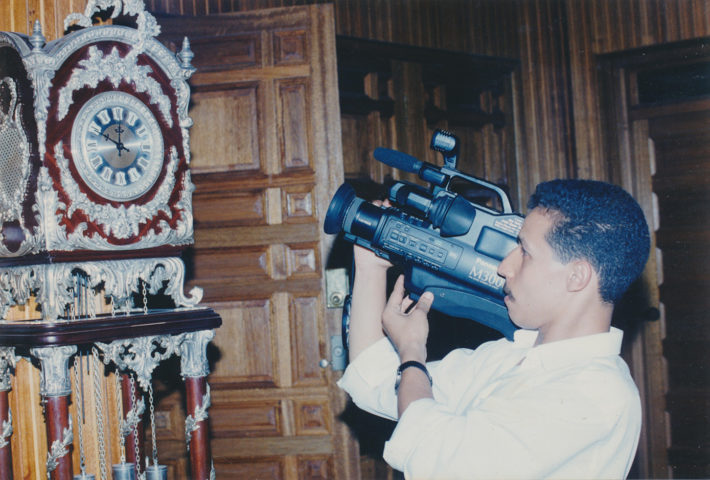
From In Almost Every Picture #12. Published by KesselsKramer, Amsterdam, 2013.
Have you found significant difference between family albums from different cultural and geographical contexts?
Today it is hard to find differences, precisely because of the democratization of photography. In family albums, though, they were obvious. For example, all the Swiss albums are very neat: the pictures are glued on in a systematic way, with clearly aligned and underlined captions. They are very precise. In America, the glut of images had already begun with the spread of instantaneous photos: everyone could afford to buy a cheap camera—a bit like now, but of course in smaller quantities. In Bulgaria, the albums are very small, as are the prints, for reasons of cost. For me these aspects have a more technical significance, but they can certainly suggest numerous reflections.
Your work is filled with vitality, and at the same time death is a strong presence. This is an even more touching aspect in the case of the video My Sister (2011). Anyone who watches that video knows that that little girl no longer exists, and yet she will go on gazing into your eyes for eternity.
This is a crucial point for me, because above and beyond my battle against perfection, my line of research—my interest in the narrative potential of pictures and albums—has a great deal to do with the fact of having had to deal with the death of my sister at a very young age. When you’re eleven it’s not possible to comprehend such an event. After two or three months it already tends to fade. For me it has been more significant to observe what it took for my parents to return to normality. Looking at the photographs of my sister in the family album, we found the last picture of her (at the origin of the exhibition project One Image, 2016, interviewer’s note). It had been taken by an anonymous photographer at a summer camp, and we were in the picture too. A souvenir of the vacations. My parents had started to cut the picture, keeping her figure and removing us, isolating her. Then they turned it into a black-and-white image, reprinted it and hung it on the living-room wall. It was an act of reappropriation. They turned that photograph into a monument, and I made that gesture mine. Perhaps, unconsciously, the very fact of taking someone’s picture for a family album has something to do with what comes after. The moments we capture are not perhaps all that important, but they remain. This reflection led me to take the series of pictures of my children when they had hurt themselves (My Family, 2000-in course): for me they are very significant pictures, because they are not ones we normally take.
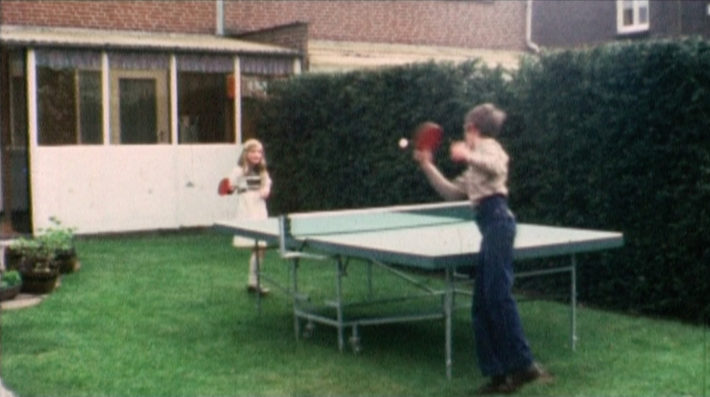
From My Sister, video, 2011.
Today we tend not even to look at the photographs we take again, we are not constructing any memories. What is the family album today?
I think that today’s family album only exists in real time. It is synthesis and sharing, who knows where it is going? Perhaps twenty, forty years ago, people had a clearer idea of the future: there would be computers, viaducts, electric trains and advanced machinery. There were fantasies about it. Now, if someone were to ask you “what is the future?” there isn’t much to say, we are living in the future. No one has a clear idea of how the world might be in twenty years. With the exception of negative phenomena like climate change. This predominance of real time may be the reason we no longer make family albums: the memory is shared, and is exhausted as soon as we put ourselves on show through our Instagram profiles. Which is fine, sharing is fine as well, we just have to be aware of the difference. This can be seen in music too—although some people have gone back to buying vinyl records. We had CDs, then digital files and now not even those, we listen to streamed music. We no longer keep anything.
What attitude do people have today toward privacy?
Whatever may be said about it, people have no problem with the loss of privacy. Companies like Facebook, Twitter and Instagram, as well as Airbnb and Uber, have too much power. They use our data unscrupulously, but no one really criticizes them for it. If what they offer is convenient and cheap, people say, why not take it?
What do you do when you’re not looking at photographs? Do you ever feel the need to distance yourself from this constant flow of images?
My case is a very difficult one, for me it’s like a drug. I’d have to go into rehab to stop looking at things. This is why I sleep twice a day when I’m on vacation—I need to be unconscious to detach myself from images. When I’m alone in a city, I like to go to the market very early in the morning, eat something, enjoy the atmosphere by myself, but even there, when all is said and done, I go to look at images. Sometimes I try to go fishing, but I’m very impatient. We ought to be able to disconnect really. This is a problem I have in common for example with many of the people in my office, especially the creative directors: they go on vacation and spend their time taking photographs. It almost seems as if that is what they go on vacation to do.
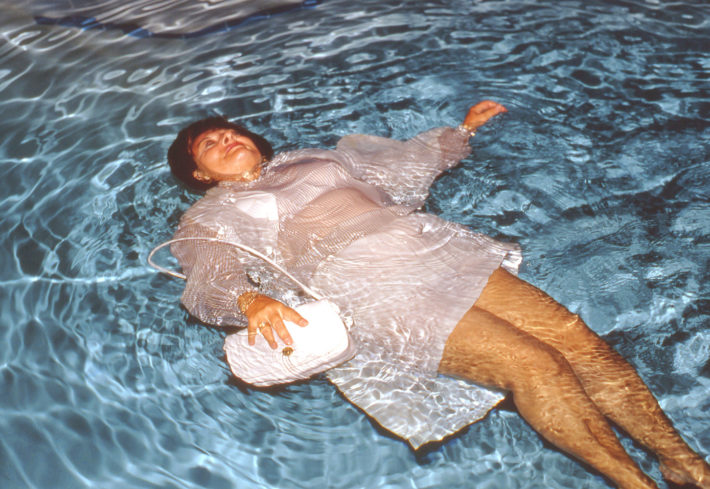
From In Almost Every Picture #11. Published by KesselsKramer, Amsterdam, 2012.
In the series of photos of twin sisters (In Almost Every Picture #04, 2005), at a certain point one of them disappears. The other, curiously, keeps to one side of the frame, leaving an empty space where her sister had been. Your reading of the story suggests that one of the two may have died. Reversing the perspective, who do you think was behind the lens? Are you always able to trace the authors of your series?
In the case of the twin sisters, I don’t know the real story. There might be a good 80-90% of truth in my version, but I can’t be sure about it. At the beginning of the series, when the twins always had their picture taken together, the photographer was not someone they knew because the formal structure of the image is always the same. In the majority of cases the sisters are walking along the Rambla in Barcelona, they are dressed the same and they are there on a Sunday or after work. There used to be many photographers wandering around the Rambla, taking pictures and giving out tickets with which people could pick up their photos a few days later. When the woman is left alone, she always poses on the left or right of the shot. Who took the pictures? Who knows, perhaps one took photos of the other. But the answer doesn’t matter, because it is exactly this question, this kind of curiosity, that I want to arouse. Sometimes the solution is obvious, sometimes funny, at others very profound. For sure, I’m fascinated by the shortness of the time that passes between birth and death. If you think about it, from the point of view of images life is compressed, like a jpg. When my family and I started to look at the photographs of my sister, it was strange to discover how few of them we had. When I found my father’s Super-8—five hours of recording—I discovered that the clip which was later presented in the video My Sister was the only one in which I and my sister appeared together. A ping-pong game, lasting a minute and a half. In the video, that brief moment is extended, blown up, as if it were possible to lengthen a life through film. How often do we take pictures of members of our family, of our children, when they are not doing anything? Or, for example, when they are crying or sticking a finger up their nose? Never. We make family albums: sit straight, pose, smile. It is weird.
Speaking of family photographs on other occasions, you’ve used the term propaganda. Could you say more about this?
This is the time of propaganda of the self, just look at Instagram. People go on recording their lives: when someone goes into a store to buy a book, he immediately takes a picture of his new acquisition, with a cappuccino next to it, as if to say: look, this is my life, it’s nice. And so you find millions of photographs of books with something next to them. They are evidence that the life of the person who has taken them is a good and perfect one. When I did the book on imperfections (In Almost Every Picture #13, 2014), I was really fascinated by the way people took pictures of that book. All of them perfect, vivid, with filters. Then I asked myself, why not play with it and do something imperfect?
You claim that many photographs stem from boredom. To make My Feet, you typed “I’m bored” into the search engine and found many images, which were then included in the series, under that label. Putting them on display is curious way of ennobling—to use your words—human stupidity.
Yes, I think it is interesting to elevate stupidity and ordinariness. Many of my series derive from boredom, an ordinary feeling that I like to make extraordinary simply by recontextualizing it. In the days of film, you’d often see the family on vacation and the husband equipped with a Super-8. It was like therapy: if the camera hadn’t been there, there’d have been a lot of quarrels! The father of the family was a grouch, he worked like a donkey—the male brain functions in a very different way to the female one—and for him having the camera meant having control, as well as being able to photograph things. Almost all family albums are extremely boring because they contain nothing but mountains. The father made postcards while his children were doing something else right next to him, but he wasn’t even looking at them. Yet I find it charming that people devote themselves to photographing the mainstream, that everyone does the same thing. Why should they find it interesting to take pictures of a waterfall? Because you don’t have one at home, or because you don’t see one very often? So you take a picture, and it’s the most boring thing that you could do. A mountain is even more boring. But why do it? Certainly, it’s proof that you’ve been there, but then why not put yourself in the picture too? Well yes, in fact people do that now, but the level of self-promotion is ridiculous. In the sixties, Andy Warhol said that in the future everyone would be famous for 15 minutes. Brilliant. That future is now.
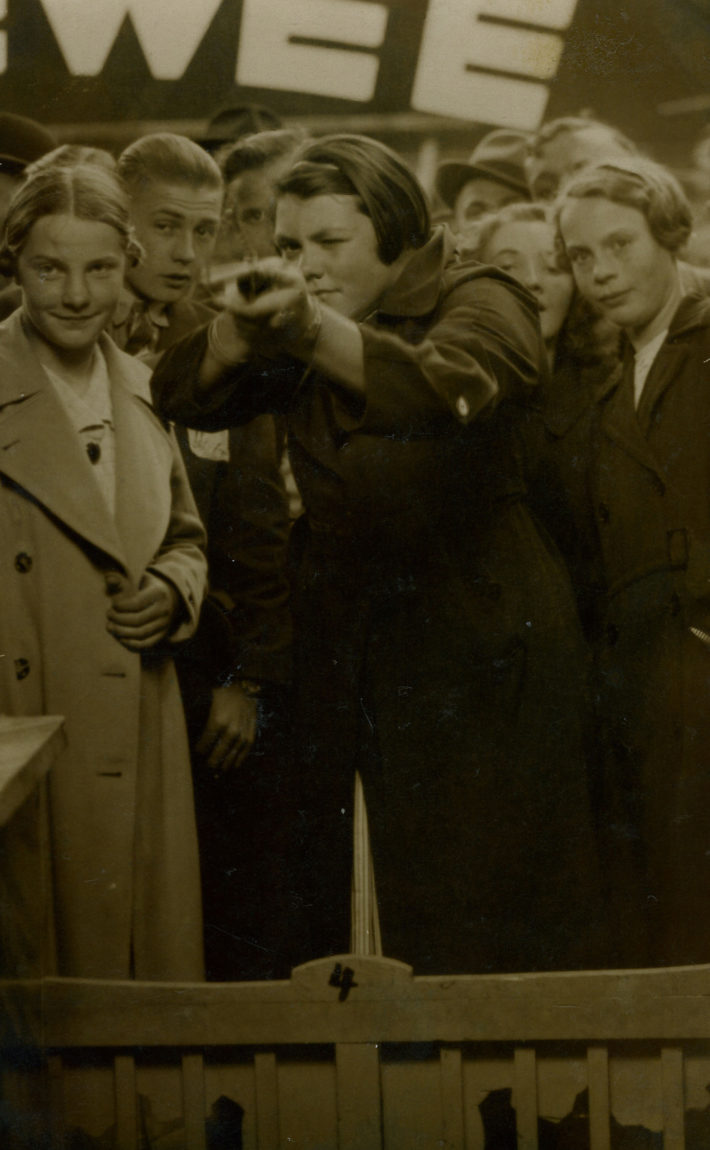
From In Almost Every Picture #7. Collected and edited by Erik Kessels and Joep Eijkens. Published by KesselsKramer, Amsterdam, 2008.
Let’s talk about your method of working. What happens between the time you get hold of the materials and the final output?
One of the most important things to say is that I’m not a photographer. Sure, I’ve taken pictures of my children and of paintings on trees (Tree Paintings, 2009), but I did it to record information, in a systematic way. I’m not at all interested in taking a beautiful photograph, printing it and hanging it up somewhere. I’m never going to do that. Working with other people’s images gives me the freedom to play with their layout. I’ve worked with photographers all my life, and I can say that they are control freaks. When they produce a series, they are often not even able to make a selection of their own photographs. When they put on an exhibition, they are unable to get away from their work, losing themselves in minor details like the wood of the frame. And in the end, they hang the pictures on a wall. That’s all. I have no emotional tie with the work in itself, simply because it’s not my work, I wasn’t even there when it happened. I’m not the author of the photographs, but of their appropriation. I can present them freely, combine them with other works and make installations out of them, because I’m not tied to the moment when they were produced. Back in 2007 I was already making use of enormous wallpaper displays, a practice that many are experimenting with today. As far as I’m concerned, I always try to make my exhibitions experiences to be lived.
What do you do with the original materials? The only ones present in the exhibition are the photograph albums in the room devoted to Album Beauty.
I’ve never been interested in showing the original sources, it’s much better like that. Often the images are very small and blowing them up makes it possible to really transform their nature. The way they have been changed is the reason why people stop to look at them. In the series My Feet, a single image means nothing, but allowing people to walk on them—and it is not such a special stratagem—completely alters their perception. It also depends on how the pictures are grouped. The albums are there just to show the material nature of the objects. Roland Buschmann, with whom I work on the design of the exhibitions, is a genius at turning the pictures into genuine works of architecture in the space.
What do you think of contemporary photographic publishing?
Enormous progress is being made in the production of photography books, a very positive development. In the pre-digital era photographers used to produce very standardized objects. Moreover, only a few had the possibility of bringing out a book. Now that there is self-publishing, photographers pay more attention to the ideas that give rise to books, working in collaboration with publishers and graphic designers. And it’s fantastic. Rightly, they are called artist’s books. Luckily, many of those trendy publishers who still go on producing those tedious oblong objects, with stiff covers and a dust jacket, are losing ground. As for me, the first book I published with my advertising agency was in 1997. Since then we have carried out 60 or 70 publishing projects, spread out over time and on different scales. We’ve never worked according to the traditional logic of a publishing house.
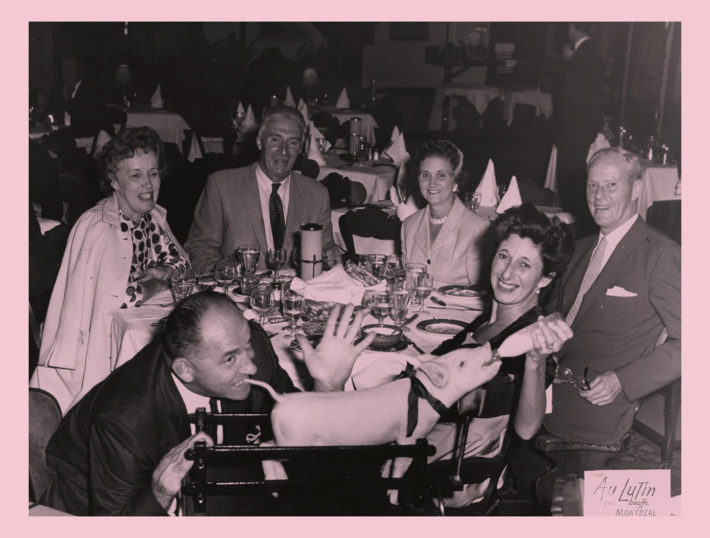
From In Almost Every Picture #10. Collected by Michel Campeau. Edited and designed by Erik Kessels. Published by KesselsKramer, Amsterdam, 2011.
The book published on the occasion of the exhibition, in its density of content and its size, seems to bring a long chapter of your career to a close. Do you see changes taking place in your research from here on?
The book, in reality, was Francesco Zanot’s idea. When Camera asked me to hold an exhibition here, he proposed it. It has been a wonderful gift. I did not have making one in mind and I have to thank him too for the involvement of Aperture. In general, I’ve never planned anything. I commenced my activity as a pastime and have found myself putting on a hundred or so exhibitions over the last ten, fifteen years. I’ve never sold anything, with the exception of loans to or acquisitions by museums. I’ve never been interested in galleries, just as no gallery has ever been interested in me. Which is fantastic, it spares you a lot of headaches. That doesn’t mean I’ll never do it, but I have the feeling that artists are very vulnerable as soon as they are represented by a gallery, since they know that that the plug could be pulled on them from one moment to the next. This exhibition constitutes a well-defined ensemble, even though I feel I’ve already taken a few steps further. In the future, I’d like to experiment more with installations and sculptures. Working on ideas, rather than on the photographs themselves. You can see this in some projects I’ve already carried out: Museum Minutes (2012-13) arises from a reflection on the fact that in museums people look at a work for an average of six or seven seconds before moving on to the next. When they’re doing sport in the gym, by contrast, their eyes are fixed on a TV screen for about twenty minutes. So I decided to combine the two things. For a permanent installation in the Netherlands, Treebench (2013), I planted a tree in a bench. In ten years, my dream is that the tree will have grown so big that it will lift up the bench and carry it with it.
The title of the exhibition, The Many Lives of Erik Kessels, describes your eclecticism well.
It is funny, and sometimes irritating, that people are always trying to classify you from the professional point of view. Who cares if I am a photographer, graphic designer, publisher, artist or creative director? Every time I show my work, whether in the guise of an adman or an artist, what interests me is to try to be disturbing. Advertising is horrible, I hate it, and yet I’ve been working in it for years, simply trying to do it in a different way. The exhibition has a variety of its own: it has to do with the beauty of the narrative and visual content, but it is also linked to set design and the experience that you can get from visiting it. With all due respect, but let’s be honest about this, museums of photography are terribly boring.

My Feet, 2014. Installation view, CAMERA 2017. Photo: Andrea Guermani.

My Feet, 2014. Installation view, CAMERA 2017. Photo: Andrea Guermani.
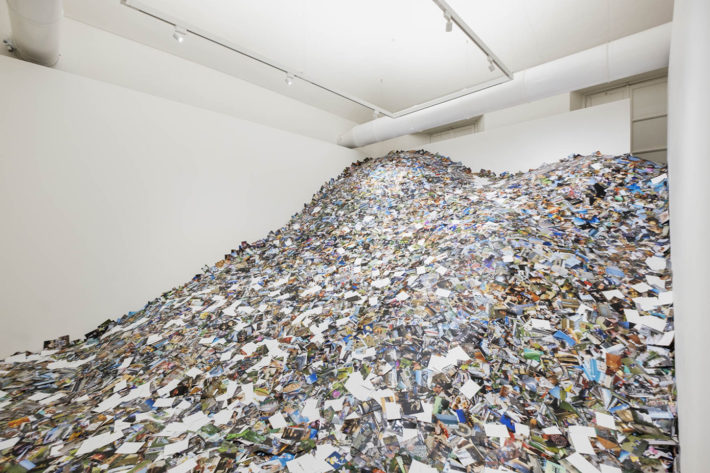
24hrs, 2011. Installation view, CAMERA 2017. Photo: Andrea Guermani.

From My Family series, 2000-in course.

From In Almost Every Picture #8. Collected and edited by Erik Kessels. Photographs by Hironori Akutagawa. Published by KesselsKramer, Amsterdam, 2009.
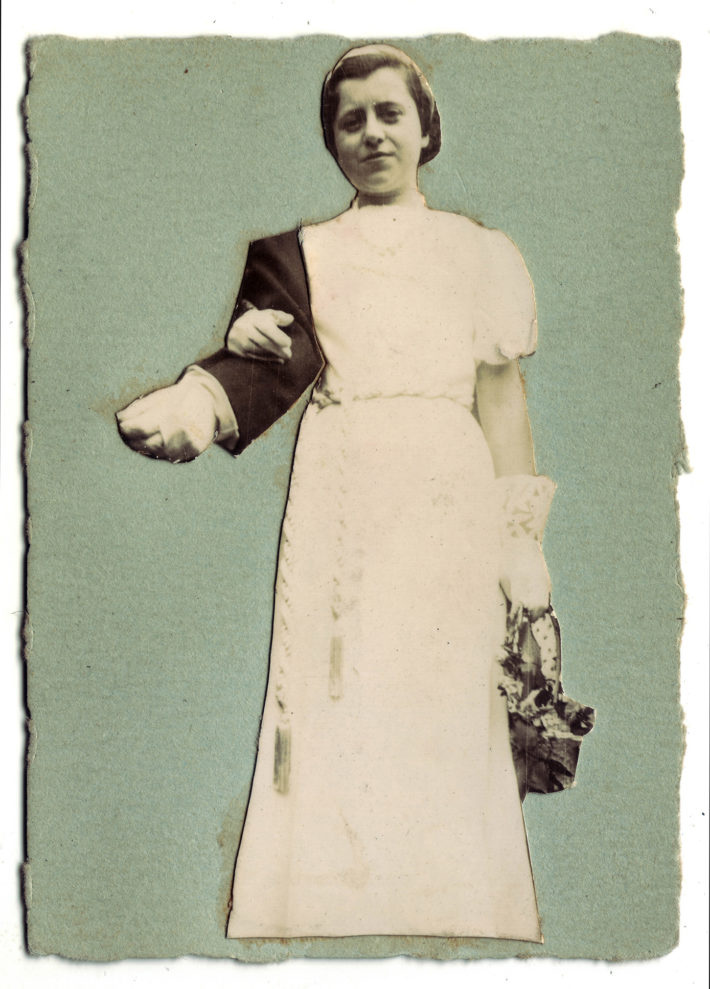
From Album Beauty. Published by RVB Books, Paris, 2012.